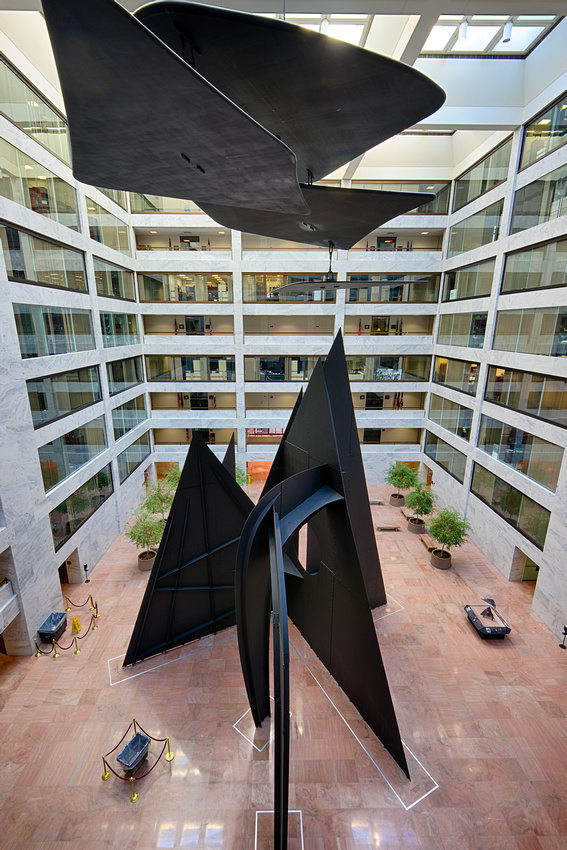Alexander Calder approached the creation of public sculpture in a unique way. His largest pieces are often set in the midst of cities, placed on plazas between modern office buildings. We have a beautiful example here in Grand Rapids, with another large one in the same bright red color, nearby in Chicago. Unlike them, Mountains and Clouds, in the Washington Hart Senate Office Building, is painted in matte black. This works well against the white marble and clear glass in the atrium where it stands. Each of these three “stabile” sculptures provides a lyrical counterpoint to the linear and grid-like facades of the office buildings. Mountains and Clouds is unique in that it also involves one of Calder’s mobiles, suspended from the atrium ceiling.
We know that monumental sculptures from earlier times often portray honored heroes, standing or on horseback. By contrast, Calder’s large works are abstract, and don’t simply draw attention to themselves. His plaza sculptures do more. They lead the observer’s eyes to notice the interplay between his work and the spaces around them, as well as their contrast with nearby buildings. One doesn’t just view these sculptures; one engages with them, and with the larger context of their placement.
Here, we must mark a paradoxical aspect of all public sculpture, which indicates something more about us than it does about the art. Many people work everyday in buildings around where these sculptures are situated. But they are just as capable of being as inattentive to these pieces of art as they are to their parking spaces or to the doors of their offices. With the stabiles’ soaring heights and reaching curves, Calder’s works are expressively shaped and tremendously uplifting. But our focus on our work and our worries, and the practical things we need to do, blinds us! And it diverts our attention from something truly beautiful, right there in front of us.
I note all this because the same thing can happen when we encounter the first verses of John’s Gospel. Often called the prologue to his Gospel, John has written a passage shaped by poetic beauty and filled with lofty theology. Yet, we have a tendency to focus on what is immediate and practical, and on what seems narrowly relevant to our everyday concerns. And so, we can go right by this Gospel ‘work of art’ just as people hurry past the great Calder downtown, absorbed with getting to their offices. In both cases, something sublime lies before us, waiting for us to engage with it. But sometimes we don’t see it because we aren’t really looking for it!
Alexander Calder, Mountains and Clouds, 1976 (installed 1986), in the Hart Senate Office Building, Washington, D.C. The beautiful photograph is by John Baggaley, and is used by permission. For a link to the website of this talented photographer, click here.
For further reflection on Calder’s stabiles, especially his Mountains and Clouds, in relation to the Prologue of John’s Gospel, click here.
